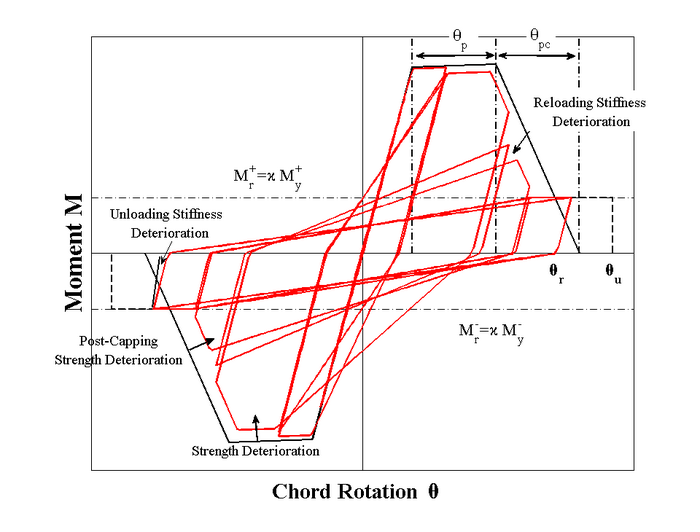Modified Ibarra-Medina-Krawinkler Deterioration Model with Peak-Oriented Hysteretic Response (ModIMKPeakOriented Material)
- Command_Manual
- Tcl Commands
- Modeling_Commands
- model
- uniaxialMaterial
- ndMaterial
- frictionModel
- section
- geometricTransf
- element
- node
- sp commands
- mp commands
- timeSeries
- pattern
- mass
- block commands
- region
- rayleigh
- Analysis Commands
- Output Commands
- Misc Commands
- DataBase Commands
This command is used to construct a ModIMKPeakOriented material. This material simulates the modified Ibarra-Medina-Krawinkler deterioration model with peak-oriented hysteretic response. Note that the hysteretic response of this material has been calibrated with respect to 200 experimental data of RC beams in order to estimate the deterioration parameters of the model. This information was developed by Lignos and Krawinkler (2012). NOTE: before you use this material make sure that you have downloaded the latest OpenSees version.
| uniaxialMaterial ModIMKPeakOriented $matTag $K0 $as_Plus $as_Neg $My_Plus $My_Neg $Lamda_S $Lamda_K $Lamda_A $Lamda_C $c_S $c_C $c_A $c_K $theta_p_Plus $theta_p_Neg $theta_pc_Plus $theta_pc_Neg $Res_Pos $Res_Neg $theta_u_Plus $theta_u_Neg $D_Plus $D_Neg |
| $matTag | integer tag identifying material |
| $K0 | elastic stiffness |
| $as_Plus | strain hardening ratio for positive loading direction |
| $as_Neg | strain hardening ratio for negative loading direction |
| $My_Plus | effective yield strength for positive loading direction |
| $My_Neg | effective yield strength for negative loading direction (negative value) |
| $Lamda_S | Cyclic deterioration parameter for strength deterioration [see definitions in Lignos and Krawinkler (2011)] |
| $Lamda_C | Cyclic deterioration parameter for post-capping strength deterioration [see definitions in Lignos and Krawinkler (2011)] |
| $Lamda_A | Cyclic deterioration parameter for acceleration reloading stiffness deterioration [see definitions in Lignos and Krawinkler (2011)] |
| $Lamda_K | Cyclic deterioration parameter for unloading stiffness deterioration [see definitions in Lignos and Krawinkler (2011)] |
| $c_S | rate of strength deterioration. The default value is 1.0. |
| $c_C | rate of post-capping strength deterioration. The default value is 1.0. |
| $c_A | rate of accelerated reloading deterioration. The default value is 1.0. |
| $c_K | rate of unloading stiffness deterioration. The default value is 1.0. |
| $theta_p_Plus | pre-capping rotation for positive loading direction (often noted as plastic rotation capacity) |
| $theta_p_Neg | pre-capping rotation for negative loading direction (often noted as plastic rotation capacity) (must be defined as a positive value) |
| $theta_pc_Plus | post-capping rotation for positive loading direction |
| $theta_pc_Neg | post-capping rotation for negative loading direction (must be defined as a positive value) |
| $Res_Pos | residual strength ratio for positive loading direction |
| $Res_Neg | residual strength ratio for negative loading direction (must be defined as a positive value) |
| $theta_u_Plus | ultimate rotation capacity for positive loading direction |
| $theta_u_Neg | ultimate rotation capacity for negative loading direction (must be defined as a positive value) |
| $D_Plus | rate of cyclic deterioration in the positive loading direction (this parameter is used to create assymetric hysteretic behavior for the case of a composite beam). For symmetric hysteretic response use 1.0. |
| $D_Neg | rate of cyclic deterioration in the negative loading direction (this parameter is used to create assymetric hysteretic behavior for the case of a composite beam). For symmetric hysteretic response use 1.0. |
Image from: Lignos and Krawinkler (2012)
The deterioration model parameters can be calibrated based on actual experimental data of RC beams in terms of load - displacement or moment - rotation. Examples of such calibrations can be found in Lignos (2008) and Lignos and Krawinkler (2012).
References:
| [1] | Lignos, D.G., Krawinkler, H. (2012). “Development and Utilization of Structural Component Databases for Performance-Based Earthquake Engineering", Journal of Structural Engineering, ASCE (accepted for publication). |
| [2] | Lignos, D.G., and Krawinkler, H. (2011). “Deterioration modeling of steel components in support of collapse prediction of steel moment frames under earthquake loading”, Journal of Structural Engineering, ASCE, Vol. 137 (11), 1291-1302. |
| [3] | Lignos, D.G. (2008). “Sidesway collapse of deteriorating structural systems under seismic excitations,” Rep.No.TB 177, The John A. Blume Earthquake Engineering Research Center, Stanford University, Stanford, CA. |
| [4] | Ibarra L.F., and Krawinkler, H. (2005). “Global collapse of frame structures under seismic excitations”, Rep. No. TB 152, The John A. Blume Earthquake Engineering Center, Stanford University, Stanford, CA. |
| [5] | Ibarra L.F., Medina R. A., and Krawinkler H. (2005). “Hysteretic models that incorporate strength and stiffness deterioration”, Earthquake Engineering and Structural Dynamics, 34(12), 1489-1511. |
Code Developed by : by Dr. Dimitrios G. Lignos, McGill University
